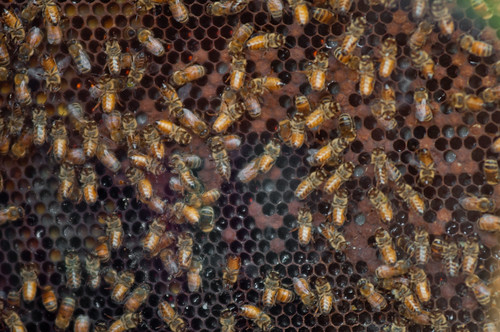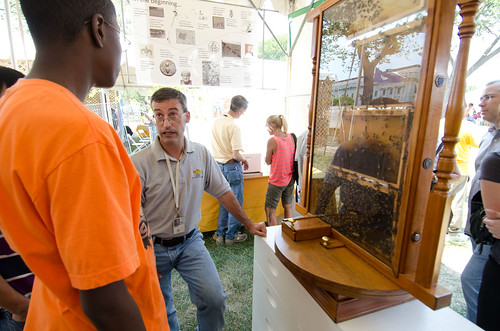
This week, representatives from USDA have been down on the National Mall, staffing hands-on exhibits about food safety, bioenergy and even bees. Agricultural Research Service (ARS) scientists have, for years, been studying Colony Collapse disorder (CCD), which has been attacking honey bee colonies since 2006.
CCD is defined by the disappearance of most, if not all, of the adult honey bees in a colony, leaving behind honey and brood, but no dead bee bodies. This definition has recently been updated to include low levels of Varroa mite and other pathogens, such as Nosema, as probable contributing factors.
While the exact cause of CCD has not been found, honey bee losses have leveled off this year. In 2006 when CCD first appeared, some beekeepers reported 30 to 90 percent losses in their apiaries. For the next three years, beekeepers reported that winter colony losses were averaging around 30 percent, with one-third attributed to CCD -- a loss rate that is not economically sustainable for commercial beekeepers.
So ARS scientists keep at it, following the science wherever it leads, looking for the answer to this critical problem. While they're hard at work in the labs, other USDA employees often take a sample bee hive on the road to help the public understand both the great contributions bees make to our world and to help engage people in supporting honey bee health.

At the Festival, volunteer beekeepers are answering questions and sharing their enthusiasm for caring for their bees. Volunteer Toni Burnham explained that "all beekeeping is local." As Vice President of the Maryland Beekeepers Association, she is well-versed in how bees interact with the tree canopy in Washington, D.C., which offers bees a wealth of nectar to feast on. She especially pointed to the long street called Massachusetts Ave. that is most known for the fact that it hosts Embassy Row, leading from downtown all the way out to the National Cathedral. But what it should also be known for is that it’s a great food source for bees. Many years ago, the city planted Linden trees the entire length of the street. These trees produce nectar for a longer period of time than other trees and produce more than their counterparts in the suburbs. It turns out the nation’s capital is a great place to be a bee!
If you have questions about beekeeping or bee health in your community and can’t get to the Mall here in D.C. to ask our ARS specialists, you can find educational resources – supported by USDA’s National Institute of Food and Agriculture (NIFA)’s eXtension initiative – to answer your questions. Go to www.extension.org/bee_health for the Bee Health Community of Practice, where you’ll find FAQs about beekeeping and bee health.
The Folklife Festival resumes again tomorrow, July 4th, through Sunday July 8th.


